Course Description
This was an introductory course for the Instructional Design, Development and Evaluation Master of Science degree. The course provided an introduction to basic learning and design theories that contribute to creating effective instruction. The topics are covered in the course for us to have the ability to facilitate the process of prescribing solutions to instructional problems. During this course, we worked to build models of learning theories regarding what they are, how they related to one another (or do not) and how they may be applied to create instructions.
Learning theories
Behaviorism

Cognitivism
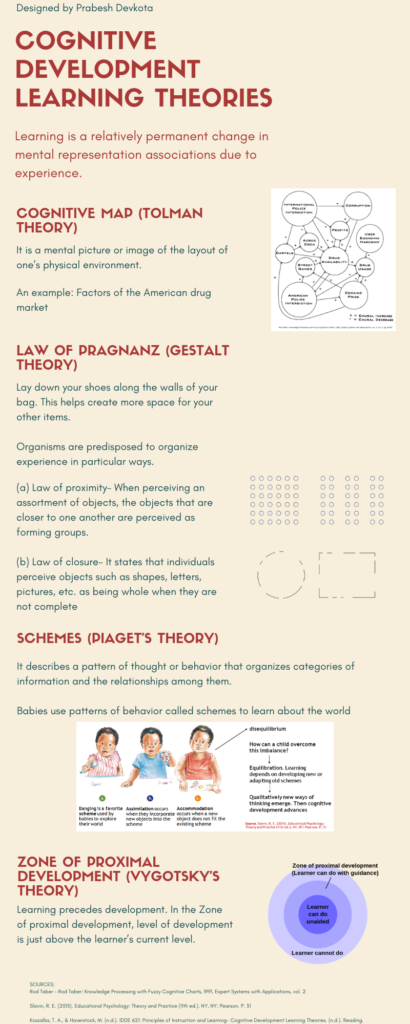
Social Learning
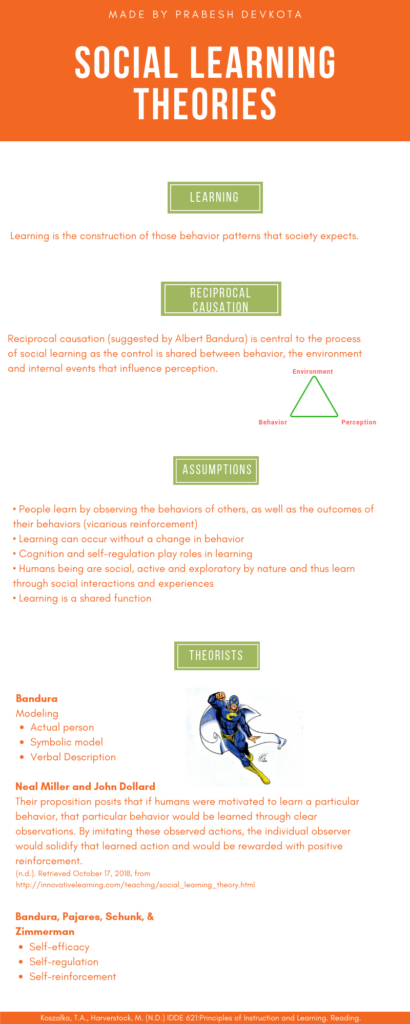
Instructional Theories
Behaviorism
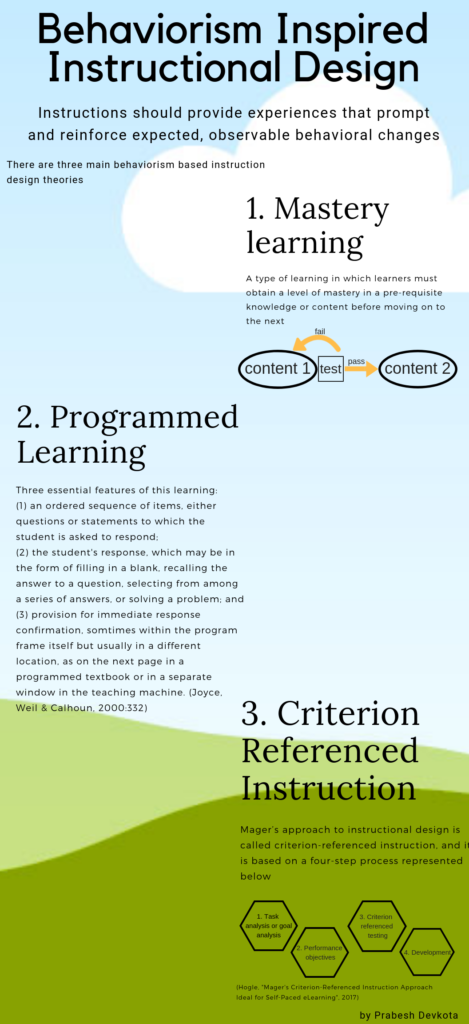
Cognitivism
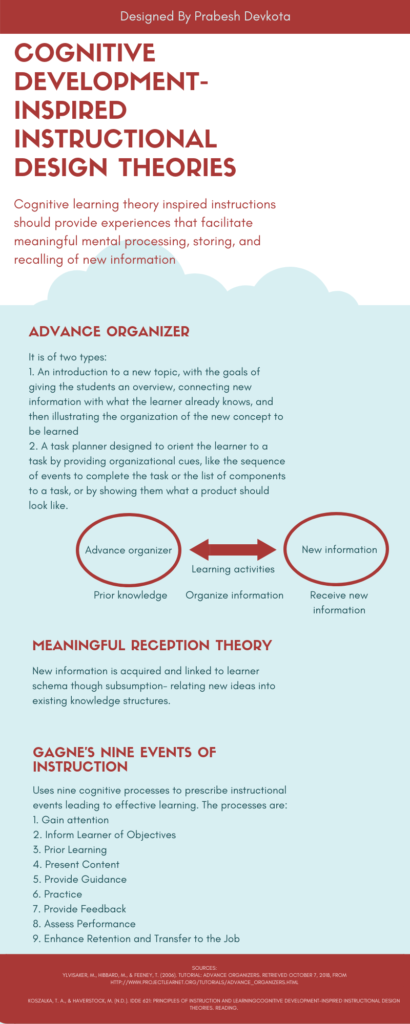
Social Learning
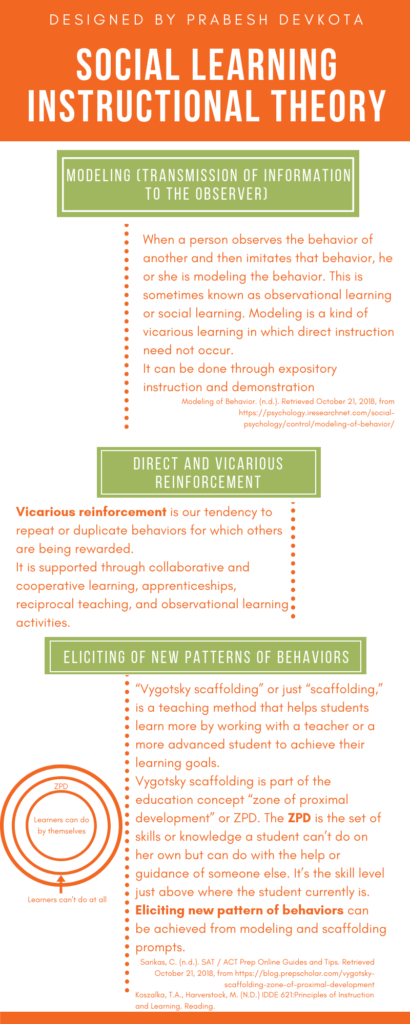
Learning Situation
Behaviorism
Hired five data entry personal to enter data from a survey from Myanmar into a database. They were paper based surveys done in pilot and control areas to capture various socio-economic data related to value chain analysis. These data were to be entered into a database in SPSS (very similar to entering data into excel or other spreadsheets) (STIMULUS). Most of the data entry personnel had experience in data entry for surveys, and that too in softwares like SPSS and excel. Data entry itself was not much of an issue for the entry personnel. The main issue was making sense of data captured in the paper based surveys and in translating it into appropriate entries on the database.
The database in SPSS was created mainly by a colleague who had traveled to Myanmar to supervise the survey on the ground, with some of my inputs. I went over all the questions in the survey one by one with the group of five highlighting the MCQ’s, open entry questions, numeric entry questions, cross checking entries, dealing with entries beyond the major scope of the survey and so on (STIMULUS). Then the task was for installing SPSS into all the data entry personnels computers and asking them to do a mock entry of data. This allowed the personal to actually put the paper responses made on the ground to fit the format created by the database(RESPONSE).
The data entry personal brought their own previous experiences of data entry (and in some cases data analysis!) into this process. They refined the database itself with its flaws and helped refine the entry process (GENERALIZATION). This collective process brought an updated database which was to be used for data entry.
During data entry, the databases had certain variances in weather they were control databases or pilot ones (STIMULUS). Also, extreme answers and outliers had to find ways of entry into the database which was sorted as we worked (RESPONSE). There were about 150 surveys to be entered by the 5 people. The first surveys went slow and changes had to be made at times and notes taken in the beginning. But things started rolling as we worked through and towards the end data entry was fast. The whole process took just over a week time.
Cognitivism
Hired five data entry personal to enter data from a survey from Myanmar into a database. They were paper based surveys done in pilot and control areas to capture various socio-economic data related to value chain analysis. These data were to be entered into a database in SPSS (very similar to entering data into excel or other spreadsheets). Most of the data entry personnel had experience in data entry for surveys, and that too in softwares like SPSS and excel. Data entry itself was not much of an issue for the entry personnel (PRIOR LEARNING). The main issue was making sense of data captured in the paper based surveys and in translating it into appropriate entries on the database (RETENTION AND TRANSFER).
The database in SPSS was created mainly by a colleague who had traveled to Myanmar to supervise the survey on the ground, with some of my inputs. I went over all the questions in the survey one by one with the group of five highlighting the MCQ’s, open entry questions, numeric entry questions, cross checking entries, dealing with entries beyond the major scope of the survey and so on(SCHEMA). Then the task was for installing SPSS into all the data entry personnels computers and asking them to do a mock entry of data (REHERSAL). This allowed the personal to actually put the paper responses made on the ground to fit the format created by the database (REHERSAL/PRACTICE).
The data entry personal brought their own previous experiences of data entry (and in some cases data analysis!) into this process (PRIOR LEARNING). They refined the database itself with its flaws and helped refine the entry process (ASSIMILATION). This collective process brought an updated database which was to be used for data entry.
During data entry, the databases had certain variances in weather they were control databases or pilot ones. Also, extreme answers and outliers had to find ways of entry into the database which was sorted as we worked (COGNITIVE MAPS). There were about 150 surveys to be entered by the 5 people.The first surveys went slow and changes had to be made at times and notes taken in the beginning. But things started rolling as we worked through, and towards the end, data entry was fast. The whole process took just over a weeks time (ASSESSMENT).
Social Learning
Hired five data entry personal to enter data from a survey from Myanmar into a database. They were paper based surveys done in pilot and control areas to capture various socio-economic data related to value chain analysis. These data were to be entered into a database in SPSS (very similar to entering data into excel or other spreadsheets). Most of the data entry personnel had experience in data entry for surveys, and that too in softwares like SPSS and excel. Data entry itself was not much of an issue for the entry personnel. The main issue was making sense of data captured in the paper based surveys and in translating it into appropriate entries on the database (PROMPTING THE LEARNER).
The database in SPSS was created mainly by a colleague who had traveled to Myanmar to supervise the survey on the ground, with some of my inputs. I went over all the questions in the survey one by one with the group of five highlighting the MCQ’s, open entry questions, numeric entry questions, cross checking entries, dealing with entries beyond the major scope of the survey and so on(CONSTRCUTING KNOWLEDGE/ EXPOSITORY INSTRUCTION). Then the task was for installing SPSS into all the data entry personnels computers and asking them to do a mock entry of data. This allowed the personal to actually put the paper responses made on the ground to fit the format created by the database (ZPD/ SCAFOLDING).
The data entry personal brought their own previous experiences of data entry (and in some cases data analysis!) into this process (RECIPROCAL TEACHING). They refined the database itself with its flaws and helped refine the entry process. This collective process brought an updated database which was to be used for data entry (SOCIAL NATURE OF LEARNING/ COLLABORATIVE LEARNING).
During data entry, the databases had certain variances in weather they were control databases or pilot ones. Also, extreme answers and outliers had to find ways of entry into the database which was sorted as we worked (PROMPTING THE LEARNER). There were about 150 surveys to be entered by the 5 people.The first surveys went slow and changes had to be made at times and notes taken in the beginning. But things started rolling as we worked through, and towards the end, data entry was fast(SELF-REGULATION). The whole process took just over a weeks time.
Checklist
Click on the learning theory to download the template
Behaviorism
Cognitivism
Social Learning
Reflection
Behaviorism
The concepts of behaviorism are very convincing in explaining human behavior (and even animal!). Stimulus, response, rewards, punishment, reinforcements, chaining, generalization, and so on are all concepts that are easy to follow and observe. They explain a lot.
However, these concepts of behaviorism don’t seem to explain everything. Too ignore all internal processes and thinking also seems a bit too extreme and restrictive. Learning occurs through many mechanisms in real life which are not all observable behaviors. These theories seem to be coming from individual silos, but don’t seem to be universal or unifying.
The fact that behaviorism, cognitivism and social learning theory completely reject each other makes all of them incomplete in my opinion. Trying to explain certain behaviors through behaviorism may seem appropriate, but there will always be many aspects of learning that behaviorism would have a hard time to explain.
Cognitivism
Cognitive learning and instruction theory give a new way of looking at learning and instruction. In contrast to behaviorism, which was based on observable things, cognitivism accepts thinking process as learning. This may not be directly observable ever, which would not be accepted by behaviorists. However, learning usually manifests in behaviors that can be observed.
Cognitive learning theories almost seem like a natural growth from behaviorism. It is clear while using behaviorist terms to understand learning, that it is leaving quiet a few things out. Cognitivism talks about mental structures or schemas of learning. Humans are said to organize experiences in certain ways. Humans acquire knowledge and form mental images of them.
Cognitivism explains memory and storage concepts. Humans clearly take knowledge and store it in memory. These memory form the basis of learning. There is also the aspect of experience in cognitivism as humans take in new knowledge and try to associate it with things they already know. This new information can be assimilated or accommodated to form learning.
Cognitivism begins with the senses. Our sensory receptors are constantly bombarded with stimulus. Most of these never register, but some do. The things that register can move from short term to working memory, and if seen necessary by the individual move to long term memory. Thus learning can be enhanced by structuring ways to enhance required senses to make it through this process by ways like scaffolding.
Perception is another concept that is explained by cognitivism. The same experience might be stored by different individuals in different ways. Perception may also be different from reality. Some learning processes are unique to humans, like languages; which is in contrast to equipotentiality explained earlier.
Social Learning
Social Learning focuses on constructing behavior that society that society expects. This adds a new social component into learning. We behave in ways that society expects us to. We choose to learn certain things. This is in contrast to cognitivism, which is based on acquiring knowledge. There is a choice to learn in social learning, in contrast to cognitivism.
Reciprocal causation is also a unique thing in social learning, that is different from the two earlier theories. It emphasizes shared control to behavior, perception and the environment. Learning in according to this theory may also not lead to any behavior change. Learning is a social, or shared function. Language plays an important part in learning.
Vicarious reinforcement, which is learning by observing the outcomes of others behavior is essential part of social learning. This is also applied in learning from models. We model our behavior directly or indirectly after certain “models”. Observation is a method of learning.
Social learning theory allows the individual to choose what learning is going to occur. They can choose what to learn, and what knowledge is to be constructed mentally. Scaffolding assists the learning process.
Final Thoughts
In the course Principle of Instruction and Learning, we learned the learning theories along with instructional theories in the order (1) Behaviorism (2) Cognitivism (3) Social Learning. Due to this order, I did not know any other learning and instructional theory prior to behaviorism, I only knew Behaviorism when I was learning cognitivism, but when I learned of social learning, I knew the other two theories. I do wonder why this was the way it was taught, and if this is the best order.
Learning theories describe learning, and instruction theories prescribe learning. Of course learning and instruction were things we new well about from a young age, although we did not know how to define them or theories based upon them. Even some of the instructional theories were known before as ways of teaching and learning. However, going through these theories clearly defined the theories and instructions that go along with them.
Behaviorism seems to be a theory based upon our basic instincts. It deals with stimulus, response, conditioning, extinction, chaining shaping and the like. It tries to describe and prescribe learning based upon actions and reactions that have been built into out species. This theory can be used to describe and prescribe learning beyond our own species and experiments have been done on animals showing these behaviors. Behaviorism assigns control to the environment and hence the environment should be free from distractions/contamination for best results. The theory explains only the learning which can be observed.
Cognitivism deals with metal representation of knowledge. We tend to associate things and relate things to previous knowledge. This is used as basis for learning. It kind of describes learning like how a computer would be structured with stimulus input, registry, working memory and long term memory (storage). It assigns control to thinking as learning can occur without a change in behavior. Of course the environment plays a role too, as the input comes from the environment through our senses.
Social Learning deals with the construction of behavior patterns based upon societies expectation. Here the role of society comes into play, and this theory deals basically with learning in humans. The learner can be assisted to a higher learning state with social learning based theories. It relies on human nature which is explained as social, exploratory and active in nature. In this theory, there is shared control between the environment, behavior and perception.
A particular learning situation can be described in different ways using instruction based upon the three theories. However, these three theories reject one another. There exists no overlap between the concepts that the three theories purport.
The relationship between the three theories
The environment can be used as the point to show the relationship between the theories as all three theories deal with the environment in one way or the other. Social learning would also be concerned with behavior and perception, while cognitivism would be concerned with the thinking process.
Table showing relationship between Behaviorism, Cognitivism and Social Learning
| Behaviorism | Cognitivism | Social Learning | |
| Learning defined | Learning is a relatively permanent change in observable behavior as a result of experience | Learning is a relatively permanent change in mental representations or associations due to experience. | Learning is a construction of those behavior patterns which society expects. |
| Theorists | Pavlov, Skinner | Tolman, Gestalt, Piaget, Vygotsky | Bandura, Miller, Dollard, Pajares, Schunk, Zimmerman |
| Key terms | Stimulus, response, conditioning, extinction, spontaneous recovery, chaining, shaping, reinforcement, punishment, generalization | Cognitive map, Law of proximity, Law of closure, Law of Pragnanz, Schemes | Reciprocal Causation, Modeling, Self-efficacy, Self-regulation, Self-reinforcement |
| Instruction theories
|
Programmed Instruction, mastery learning, criterion based learning | Advanced organizer, Meaningful reception theory, Gagne’s Nine Events of Instruction | Modeling, Collaborative learning, Cooperative learning, apprenticeships, reciprocal teaching, scaffolding |
| Control | Behaviorism assigns control to the environment | Cognitivism assigns control to thinking | Social Learning assigns shared control to thinking(perception), the environment and Behavior |
| All three theories reject one another. | |||
Choosing among the theories
All three theories have been very helpful in changing my understanding about learning and instructions. Each theory sounded like it was good at explaining learning while going through its content. I would have preferably not liked to choose any theory among these three. All three, Behaviorism, Cognitivism and Social Learning, have interesting theories that are built on strong foundation of logic that are convincing in their own light. But I guess we have to accept the fact that these are all just theories, and probably just the best explanation that has come up so far for these concepts. Hence, no theory can be absolute.
Now if I were compelled to choose between the theories, I would like to choose cognitivism and social learning. Communication and being social are central to us humans, and hence the two theories would be the best to describe learning. I have an interest in human history and evolution (and look at things through this lens), and clearly these show that communication and ability to cooperate in large scales is central to why the human species dominate the world. This perspective would kind of indicate that what behaviorism learning theory has advocated to be incomplete.
Of course equipotentiality is a very logical way of explaining behavior in many species. Behaviorism is based on this principle and makes a lot of sense. Again, looking at this from a point of evolution and human history, we are just another species of animal that has evolved, and we have other cousins in the animal kingdom. Hence it makes sense that our instincts can be the same (as other species), and thus we can learn things in similar ways. It must also noted that the experiments mentioned by behaviorists on animals seem to be species of mammals, which are close to human beings in many ways.
The thing that clearly separates us from other animals (and other close cousins in the animal kingdom, like apes and other mammals) is our ability to communicate through language and ability to cooperate in large scale. This clearly underlines the importance of language, culture and society. Taking this factor into account, learning is better explained by cognitivism and social learning theories. Besides this, as learning that I have encountered in my life is mainly based on learning exclusive to us humans, these two theories resonate better with me.
Once more, I would like to refer back to communication and being social in larger scales being unique to humans. Cognitivism explains human communication role in learning, and social learning theory explains learning in terms of social interactions. Also, a lot of things that we learn modern education is based on theories and concepts that are not always done practically or not always shown in behaviors. This also makes behaviorism incomplete.
If I were made to choose between cognitivism and social learning, I would have to slightly side more with social learning. Social learning explains learning in terms of social interactions and so would be better among these two theories. Hence, I would choose Social Learning as my favorite. Again, I would like to emphasize that each theory is based on good logic and explain things very well when looking at it from their own perspectives.
Describe and prescribe learning
Our goal in this course, and in other things we have done in the past, is mainly concerned with learning and delivering instructions. So we really don’t need to choose a theory. We are mainly concerned with which theory describes, and prescribes learning on a particular theory in the best way. Hence we can pick and choose among behaviorism based, cognitivism based and social learning theory in a particular situation if it helps out goal. Looking at things from Blooms taxonomy perspective, we can choose how best to prescribe learning based on the level of thinking our learning goals best correlate with.
For more information
Final Grade: A-
Reflection
The course was a very good course that gave the basics of instructional design. This was very essential to me, as I came from an academic background that is very different from this whole discipline. I did not have a supporting academic base coming into this field although my past work experience (in Monitoring and Evaluation) related to this field. The different projects in this course (there were many), may have seemed to be quite unrelated at the beginning, but did make sense as a whole towards the end. Further, the course makes much more sense now- that I look at it after completing all the required courses of the MS. I really appreciate the activities, projects, readings and discussions that were made during the course, as it was well designed to give us the basics required for the MS program.